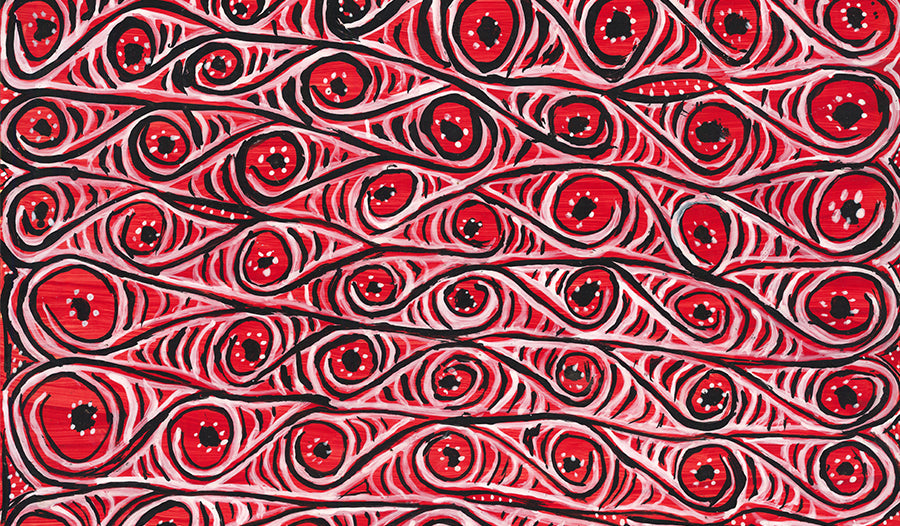
GREEN SKY, BLUE GRASS
 Image: Andrias Aimo, 2019, Etoka Enunga. Acrylic on paper. Avim, Upper Korewori, New Guinea. Collected by Tomi Bartole, 2019. Collection Weltkulturen Museum.
Image: Andrias Aimo, 2019, Etoka Enunga. Acrylic on paper. Avim, Upper Korewori, New Guinea. Collected by Tomi Bartole, 2019. Collection Weltkulturen Museum.
In Japanese poetry, the sky is sometimes described as ‘green’ (midori), while the grass is labelled ‘blue’ (ao). A colour attribution which is very unusual and bewildering for speakers of European languages. This has provided the inspiration for the exhibition title Green Sky, Blue Grass: Colour Coding Worlds, which is both intentionally confusing and designed to make people think. At the same time, it refers to the complex associations we encounter when looking at colour as a cultural phenomenon.
After all, our world is full of colour, but do all cultures see it in the same way? While the scientific basis for perception is identical for everyone, light waves can’t really explain how we name our impressions of colour, the number (and kind) of categories we divide these colours into, or the meanings and associations we ascribe to them. These can sometimes differ enormously depending on the language and culture involved.
 Image: Armlet (detail), Feathers, barkcloth, palm leaves and cotton. Kayapó Txukarramãe, Pará, Brazil. Collected by Luiz Boglar, 1988. Collection Weltkulturen Museum. Photo Wolfgang Günzel.
Image: Armlet (detail), Feathers, barkcloth, palm leaves and cotton. Kayapó Txukarramãe, Pará, Brazil. Collected by Luiz Boglar, 1988. Collection Weltkulturen Museum. Photo Wolfgang Günzel.
Since colour is not necessarily universal and therefore as an example, the meaning of the Japanese word ao is not identical to the English term blue. This is also the case with midori, which is quite distinct from green. Since, neither the colourspace nor the meaning of the colour-terms are identical, Japanese poetry can absolutely describe a ‘green sky”’ and ‘blue grass’.
After a thorough introduction into the physics, linguistics and material properties of colour and coloured materials, with around two hundred exhibits from the collections of the Weltkulturen Museum, including objects from New Guinea, Polynesia, the Amazon region, East Africa, Tibet and Java, the exhibition examines the wide range of contextual meanings for colour as a cultural phenomenon.
 Image: Ear pendant (detail). Beetle wings, feathers. Jíbaro_Shuar, Peru. Collected by Alfred Großmann, 1925-1930. Collection Weltkulturen Museum. Photo Wolfgang Günzel
Image: Ear pendant (detail). Beetle wings, feathers. Jíbaro_Shuar, Peru. Collected by Alfred Großmann, 1925-1930. Collection Weltkulturen Museum. Photo Wolfgang Günzel
Exhibits drawn from the museum’s own collections include imposing ancestral figures, magnificent feather adornments and potent sago palm sheath paintings – but it is the little things that astonish and give pause for thought. The red shells, coloured glass beads and flamboyant feathers are like pieces of a mosaic: individually they seem unremarkable, but when placed together each piece plays a role in creating a kaleidoscopic whole.
A central theme is that of the diverse cultural concepts associated with colour across the world. Among the Abelam people from New Guinea, the traditional colours black, white, red and yellow are ceremonially employed to make contact with the sacred, the ancestors, and the beyond. This is an indigenous colour system that is a central element of rituals, generates images, ancestral figures, masks and through body paint and coloured adornments also ritual dancers, who are connected to a world of experience beyond the everyday. The puppets in the Javanese shadow play indicate both their character traits as well as their emotional state, which can change from scene to scene along with the colour; black designates a mature and noble character, white means wise and pure, while red is the colour of villains and shows anger but also fearlessness in battle. At the same time the colours in the shadow play enable the characters to be situated within the Javanese cosmology.
 Image: Exhibition view “GREEN SKY, BLUE GRASS. Colour Coding Words” at the Weltkulturen Museum, 2021. Photo Wolfgang Günzel
Image: Exhibition view “GREEN SKY, BLUE GRASS. Colour Coding Words” at the Weltkulturen Museum, 2021. Photo Wolfgang Günzel
The exhibition also shows two series of paintings from the village of Avim in Papua New Guinea, one from 1961 and one from 2019. These paintings using the colours red, black and white, as well as yellow, to depict scenes from mythology and the history of Avim. The paintings connect the past and the present, for it was back in 1961 that German anthropologist Eike Haberland visited Avim village on behalf of what is now the Weltkulturen Museum and collected several paintings made with natural dyes on sago palm sheath. In 2019 Anthropologist and co-curator of this exhibition, Tomi Bartole, commissioned a new set of paintings during his field research in Avim. During the two weeks of painting, the Avim men once more brought into being the spirits with whom they had recently severed all relations, under the strong influence of Christianity. It would appear, however, that the spirits – and their colours – are more vivid than ever, although now in acrylic on paper.
Colour is more than light, more than a colour concept and more than its material properties. Colours are often associated with manifold social and cosmological notions that help people find their way in the world, making sense of it and regulating how they live with each other. Exploring the meanings of the different understandings of colour means viewing cultural relationships in a new light, which in turn allows us to discover other world views.
Review by Matthias Claudius Hofmann
--
Green Sky, Blue Grass: Colour Coding Worlds is on at the Weltkulturen Museum, Frankfurt until 30 January 2022
